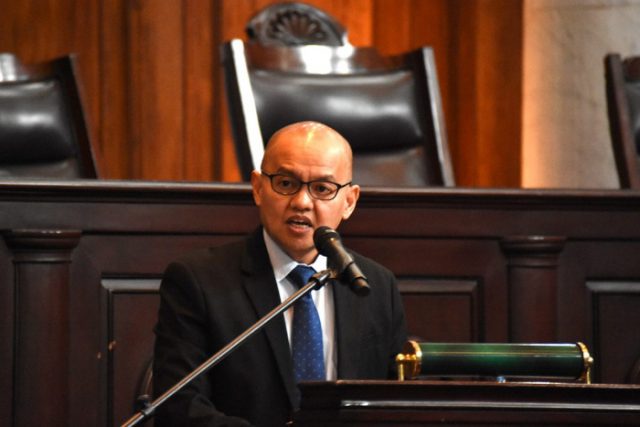
The Supreme Court’s dismissal of the same-sex marriage case was mainly due to technicalities and procedural failures on the part of the petitioners who filed the case.
In a decision last December 10, the high court denied with finality the motion for reconsideration of lawyer Jesus Falcis III for the petition to remove the prohibitions against same-sex marriage under the Family Code. Falcis initially filed the case in October 2015.
Reactions online over the junking were split between the disappointment of advocates of LGBT rights and the praises of those who disagree with same-sex marriage in a predominantly Christian country.
Some Filipinos expressed hope that a similar case will again be filed in the future. Twitter user @nickyhcastillo said that the high court still recognized the struggles of LGBT couples based on the full decision.
“The Supreme Court dismissed the same-sex marriage case on technical grounds (the petitioners did not present/prepare the case well),” the user said.
REMINDER: The Supreme Court dismissed the same-sex marriage case on technical grounds (the petitioners did not present/prepare the case well). In the full decision, the SC recognized the struggles of LGBT+ couples. @_deleonclaire breaks it down in this thread below.👇🏽 https://t.co/j8I91xi8zC pic.twitter.com/9FrBu8DpwA
— Nicky 🏳️🌈 (@nickyhcastillo) January 6, 2020
She retweeted another user’s thread in September last year when the Supreme Court first decided to drop Falcis’ case.
Lawyer Claire De Leon explained in the thread that Falcis failed to follow the basic legal process in filing cases when he immediately sought the presence of the highest justices of the land.
“The Court dismissed the case NOT on substantive, but on technical grounds, bec Falcis did not have standing, failed to raise an actual case or controversy, and violated the principle of hierarchy of courts,” De Leon said.
The Court dismissed the case NOT on substantive, but on technical grounds, bec Falcis did not have standing, failed to raise an actual case or controversy, and violated the principle of hierarchy of courts.
BUT the let me point to 3 very important parts in the statement:
2/6
— Claire De Leon (@_deleonclaire) September 3, 2019
According to Justice Leonen
The decision, penned by Associate Justice Marvic Leoneon, on the case Jesus Nicardo M. Falcis, III vs. Civil Registrar General, states that the petitioner did not follow the “standards of legal practice” and came unprepared during the oral arguments in June 2018.
Leonen cited four procedural issues arising from the petition, two of which were:
1. Does the Family Code create an actual case or controversy reviewable by the Supreme Court?
The high court did not find an actual case with the petition for it to conduct a judicial review, the ruling said.
“In a proper case, a good opportunity may arise for this Court to review the scope of Congress’ power to statutorily define the scope in which constitutional provisions are effected. This is not the case.”
2. Does the self-identification of petitioner Falcis as a member of the LGBTQI+ community give him standing to challenge the Family Code?
It found that Falcis has no legal standing to file the petition, which means he has “no personal and substantial interest in the case such that he has sustained, or will sustain, direct injury as a result of the Family Code’s enforcement.”
Leonen also defined “interest” as not mere interest in the question but a “material interest” in seeking a concrete outcome or relief. Falcis’ future plan to settle down in the country and get married to another man could not be recognized as sufficient interest as these are not “legally demandable rights that require judicial enforcement.”
“This Court will not witlessly indulge petitioner in blaming the Family Code for his admitted inability to find a partner… His fixation on how the Family Code is the definitive cause of his inability to find a partner is plainly non sequitur.”
3. Does the petition-in-intervention meant to support the main petition cure its procedural defects?
It does not. Both the petition-in-intervention, which Falcis also authored himself, and the main petition suffer “from the same procedural infirmities.” Both pleadings name the Civil Registrar General as a respondent, which the court finds as invalid.
It also saw through Falcis’ attempt to remedy the failures of his initial petition.
“This Court can only arrive at the conclusion that the Petition-in-Intervention was… not a bona fide plea for relief, but a sly, tardy strategem. It was not a genuine effort by an independent party to have its cause litigated in the same proceeding.”
4. Is the application of the doctrine of transcendental importance warranted?
Falcis invoked the doctrine of “transcendental importance” as an attempt to justify why the case should be made an exemption to the question of whether or not the Supreme Court is the proper forum to rule on the case.
The court did not see the case of a great significance enough that it should not be first taken to lower courts, which are venues to resolve questions of fact.
“Transcendental importance is not a life buoy designed to save unprepared petitioners from their own mistakes and missteps. Its mere invocation is not license to do away with this Court’s own rules of procedure.”
Previous issues
It was only after three years of filing of the petition that the SC held oral arguments on June 2018. However, it was outrightly dismissed due to procedural flaws.
At the same time, the SC found Falcis guilty of direct contempt for wearing improper attire during the preliminary conference.
In September 2019, the SC unanimously denied it, citing lack of legal standing, failure to raise an actual, justiciable controversy and violation of the principle of hierarchy of courts.
The lawyer filed a motion for reconsideration in November. The High Court made the final ruling in December.








